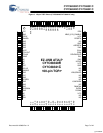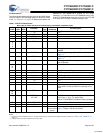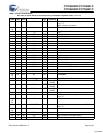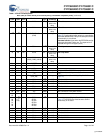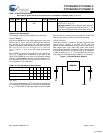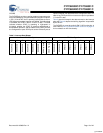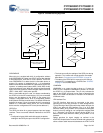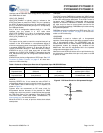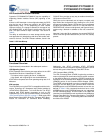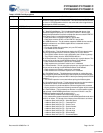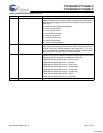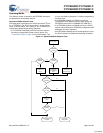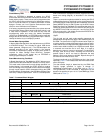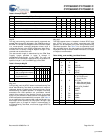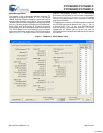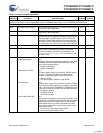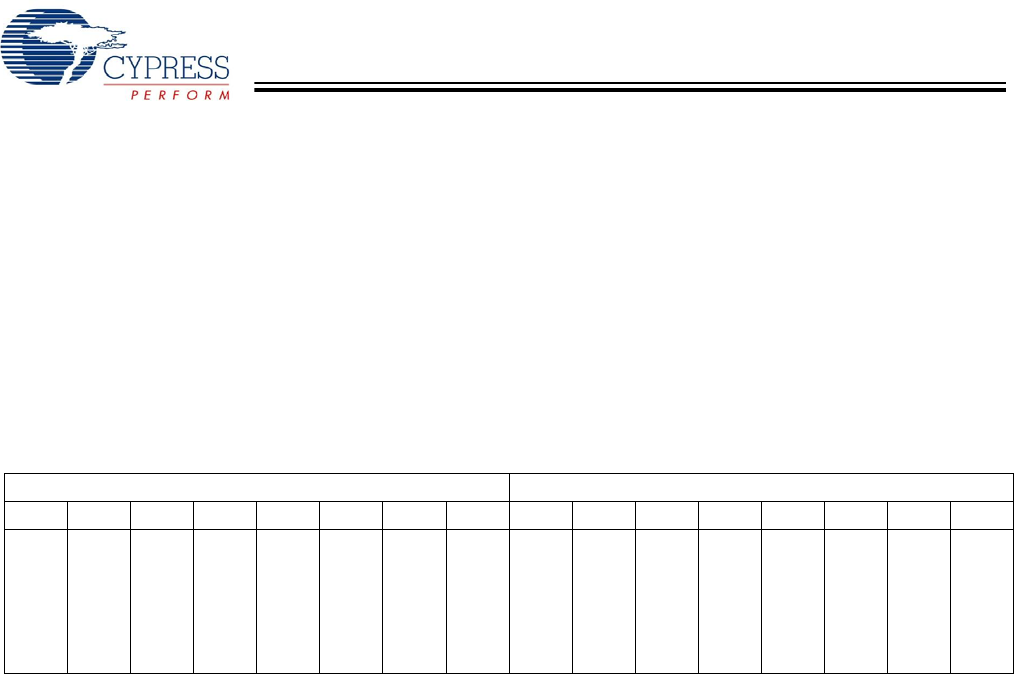
CY7C68300C/CY7C68301C
CY7C68320C/CY7C68321C
Document 001-05809 Rev. *A Page 15 of 42
HID Functions for Button Controls
Cypress’s CY7C68320C/CY7C68321C has the capability of
supporting Human Interface Device (HID) signaling to the
host.
If there is a HID descriptor in the configuration data, the GPIO
pins that are set as inputs are polled by the AT2LP logic
approximately every 17 ms (depending on other internal
interrupt routines). If a change is detected in the state of any
HID-enabled GPIO, an HID report is sent through EP1 to the
host. The report format for byte 0 and byte 1 are shown in
Table 5.
The ability to add buttons to a mass storage solution opens
new applications for data backup and other device-side notifi-
cation to the host. The AT2LP Blaster software, found in the
CY4615C files, provides an easy way to enable and modify the
HID features of the AT2LP.
GPIO pins can be individually set as inputs or outputs, with
byte 0x09 of the configuration data, allowing for a mix of HID
and general purpose outputs. GPIOs that are not configured
as inputs are reported with a value of ‘0’ in the HID data. The
RESERVED bits’ values must be ignored, and Cypress recom-
mends using a bitmask in software to filter out unused HID
data.
Note that if using the 56-pin package, the reported GPIO[5:3]
values must be ignored because the pins are not actually
present.
Functional Overview
Chip functionally is described in the subsequent sections.
USB Signaling Speed
AT2LP operates at the following two rates defined in the USB
Specification Revision 2.0 dated April 27, 2000:
• Full-speed, with a signaling bit rate of 12 Mbits/sec.
• High-speed, with a signaling bit rate of 480 Mbits/sec.
AT2LP does not operate at the low-speed signaling rate of 1.5
Mbits/sec.
ATA Interface
The ATA/ATAPI port on the AT2LP is compatible with the Infor-
mation Technology–AT Attachment with Packet Interface–6
(ATA/ATAPI-6) Specification, T13/1410D Rev 2a. The AT2LP
supports both ATAPI packet commands as well as ATA
commands (by use of ATA Command Blocks), as outlined in
“ATA Command Block (ATACB)” on page 15. Refer to the USB
Mass Storage Class (MSC) Bulk Only Transport (BOT) Speci-
fication for information on Command Block formatting.
Additionally, the AT2LP translates ATAPI SFF-8070i
commands to ATA commands for seamless integration of ATA
devices with generic Mass Storage Class BOT drivers.
ATA Command Block (ATACB)
The ATA Command Block (ATACB) functionality provides a
means of passing ATA commands and ATA register accesses
to the attached device for execution. ATACB commands are
transferred in the Command Block Wrapper Command Block
(CBWCB) portion of the Command Block Wrapper (CBW).
The ATACB is distinguished from other command blocks by
having the first two bytes of the command block match the
bVSCBSignature and bVSCBSubCommand values that are
defined in Table 6. Only command blocks that have a valid
bVSCBSignature and bVSCBSubCommand are interpreted
as ATA Command Blocks. All other fields of the CBW and
restrictions on the CBWCB remain as defined in the USB Mass
Storage Class Bulk-Only Transport Specification. The ATACB
must be 16 bytes in length. The following table and text defines
the fields of the ATACB.
Table 5. HID Data Bitmap
USB Interrupt Data Byte 1 USB Interrupt Data Byte 0
7654321076543210
RESERVED
RESERVED
RESERVED
RESERVED
RESERVED
RESERVED
USB High-Speed
VBUS Powered
RESERVED
RESERVED
GPIO[5]
GPIO[4]
GPIO[3]
GPIO[2]
GPIO[1]
GPIO[0]
[+] Feedback



